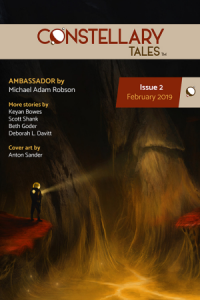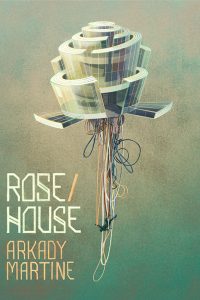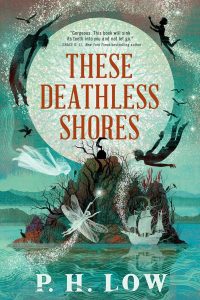Karen Burnham Reviews Short Fiction: Strange Horizons, Samovar, Constellary Tales, and Deep Magic
 Strange Horizons 4/19, 5/19
Strange Horizons 4/19, 5/19
Samovar 3/19
Constellary Tales #2
Deep Magic Spring ’19
At the end of April Strange Horizons set aside an issue to focus on Nigerian science fiction and fantasy that featured two original stories: “The Storm Painter” by Avodele Olofintuade and “Where the Rain Mothers Are” by Rafeeat Aliyu. Both happen to hit on themes of returning. Olofintuade’s story features an artist, Adé, who has been hiding her godlike nature. During one of her exhibitions, organized by her sister Nkem, she is contacted by an Orisha and others of her original family to urge her to reintegrate herself, returning to the goddess she could be. I loved the descriptions of Adé’s art in this story, and I suspect that it will be even more resonant for those more familiar with the underlying mythology. Aliyu’s story features Gherek, a woman who’s left behind a family to go see the world as a cook. When a young girl lands in her life, one who needs to be protected from her father, we learn more about Gherek’s nature and what might finally put her back on a path of reconciliation.
In May the stories seem to line up along a theme of places and how they can become more than static objects. In “Sublet” by Ian Kappos, a particular dwelling has not only the normal rooms, but also a basement accessed via the attic that leads to levels including “The Room Where My Friends Die.” This story stays firmly in the realm of the surreal as the narrator describes his relationship with that room, what he sees in it, and what his friend Isaac takes away from it. “Who Has Never Loved a Gentle House?” by Osahon Ize-Iyamu features House, who would rather be known as a Home, and the birds that harass it once it achieves consciousness (perhaps because of the books inside). The family members currently inside the House are abusive, and the House is miserable both within and without before finally breaking free of its bonds. The birds especially chip in to put this tale firmly in the weird category. “Road: A Fairytale” by Shalini Srinivasan gives us a Road, animated this time not by intellect but by the sheer weight of the anger from all the people stuck in traffic jams upon it. Road has the great introduction: “Here I am, it thought, and then, immediately: How I hate everyone.” Road makes friends with the ex-river Sludge, and occasionally asserts itself by flinging people off of itself. It eventually also comes to like some of the sewer workers, but there’s only so much that an animate road is going to put up with. Especially in Ize-Iyamu and Srinivasan’s stories, we get the feeling that in the Anthropocene it’s not just the natural world that we’re turning against ourselves. Even the structures we make might not be able to put up with us anymore.
Samovar is Strange Horizon‘s sister magazine devoted to translations. The original fantasy story in its March issue is a novelette, “Saligia“, written in Portuguese and translated into English by the author, H. Pueyo. The story is a very dark fantasy set in the late 19th century, centered on an insular family with all kinds of nasty history. Calisto is born a bastard and becomes a werewolf; his sister Violeta is clearly lighter skinned and more highly valued than he is. Their mother Cesaria is cruel to them both, trying to suppress Calisto’s nature and protect Violeta from her abusive relatives. One thing I appreciated is that we get enough of Cesaria’s story to understand why she acts as horribly as she does, which keeps her from being a one-dimensional evil mother in the piece. Eventually Calisto and Violeta make a bid to escape from their family and its legacy, but clearly nothing is going to be easy for these two. This is not a story for the faint hearted.
Constellary Tales is a new-to-me venue which I picked up with the second issue. From what I can see, it specializes in short, punchy tales, both SF and fantasy, that focus tightly on the ideas. The issue leads with “Ambassador” by Michael Adam Robson, a classic tale that develops an alien psychology and society, then introduces humans into the mix, which we then observe from the alien POV. In this case the alien society is the fungus that allows alien trees to communicate. Here a hive-mind arrangement had split into two consciousnesses, Sil and Isil, to fight off incursions from different directions, then started to battle each other for control of the original colony. When humans arrive, Sil diverts resources into trying to understand and communicate with these new beings and eventually has to choose how to use this new understanding in her conflict with Isil. I loved the idea of the consciousness down below ground, which would look almost static to human eyes. While the story glosses the substantial difficulties of establishing communications, this is a great first-contact story from the Other side. The next science fiction story, “Para Bellum” by Scott Shank, also deals with a society facing incursion. Erna is an Interceptrix who greets people who come through the wormhole nearest her community. Most of the people who come through are refugees running from the hostile Inimicus (the story is heavy on Latin). At first it looks like the latest arrival will be the same, but there are hints she might be the forefront of something much more sinister; soon Erna is in a fight both for her survival and that of her world. The story ramps up the tension smoothly and comes to nicely dramatic conclusion.
The last of the SF stories couldn’t be more different. In “Streetlight Discovers Kandinsky” by Beth Goder, self-named Dipa is a streetlight equipped with weak AI: cameras to detect surroundings and sound alarms if perceiving threats, different lighting settings, and an internet connection to get uploads and repairs. They slowly become conscious, and their journey into sapience is accelerated when they watch an art student making sketches under their lamp. The steps of a nascent AI trying to make contact with people, wracked with self-doubt, finally reaching out to the student directly, are all very charmingly done, with a focus on the power and philosophy of art. Since visual art isn’t my specialty I was moved to look up Kandinsky’s work and I’m very glad that I did.
The fantasy is similarly idea focused. “A Scent of Roses” by Keyan Bowes imagines a gender-flipped society where daughters are the prize and sons are worthless. A seventh son is murdered as an infant and proceeds to linger, haunting the household and rendering those within it barren. The grandfather, taking his responsibilities in this society seriously, engages in ever more elaborate rituals to lift the curse from his family. It’s an interesting portrait of how people can completely internalize toxic values from their cultures. The final story, “The Archmage’s Invitation” by Deborah L. Davitt shows instead a new generation looking to shake things up in their culture. Eluned is completely non-magical: she can’t use magic and it can’t directly affect her. Although her family has stayed neutral during the wars between the mages, Eluned’s condition has been shameful for them, so she’s shocked when the young Archmage Madoc ap Hywel invites her aboard his airship with a business proposition for her. He sees a different future for magic in their world and sees her “affliction” as having real value, approaching her with the respect of an equal. The story itself is quite short, but hints at all kinds of potential ripples.
Deep Magic continues to put out issues with very fun SF and fantasy stories. Their Spring issue starts with “A Reminder of Old Earth” by Aaron Perry, in which Lupe teams with Poe to smuggle avocado pits off a dying Earth. This is extremely illegal, since Earth species are aggressively invasive and destructive on all exoplanets where they’ve been introduced. Inevitably, their plans do not go smoothly and capers ensue; although this is a novelette, it doesn’t seem over-stuffed. The other SF story is “Foreign Bodies” by Melinda Brasher, where human colonists on an alien world start to come down with strange and vivid hallucinations. The colony doctors died in an early accident, leaving only a cross-trained biological researcher to try to diagnose and cure the patients – while she, inevitably, starts to suffer the hallucinations as well. It’s a classic SF problem-solving story with a satisfying resolution.
The fantasy stories start on a dark note with “Gift of Silence” by Alfred Smith. The world of this novelette features a music-based magic system. Mara isn’t terribly adept at it, but her young son Andinen becomes possessed by an entity of such power that at his debut he unleashes a holocaust that leaves the center of the city in ruins. Mara has to figure out how to protect her son from those who would kill him out of revenge and also free him from the malign influence. Parents are often absent from SF/F narratives, and I was happy to see Mara’s ingenuity with both problem solving and social navigation pay off. KM Dailey‘s “Don’t Wake the Dreamer” features an interesting perspective: a character in a dream who gains consciousness and actively works to keep the dreamer asleep. The descriptions of the dream world, especially those areas that the dreamer isn’t actively engaged with, are really well done. The final story of the issue gets back to pure fun as Carrie Anne Noble‘s “The Peddler’s Reward” lands our hero, O’Neill, in a lot of hot water. After doing one good deed, he get railroaded into betrothal to a chief’s daughter, then has to go questing for her in the Florida swamps, no matter how much he’d rather be back in Pennsylvania with a girl from his youth. Hilarity ensues as he gets help from ravens, alligators, and others, escaping from human and inhuman threats by the skin of his teeth. There’s no doubt that he’ll come out alright in the end, but getting there is all the fun.
Recommended Stories
“Streetlight Discovers Kandinsky”, Beth Goder (Constellary Tales #2)
“The Storm Painter”, Ayodele Olofintuade (Strange Horizons 4/29/19)
“Ambassador”, Michael Adam Robson (Constellary Tales #2)
“Road: A Fairytale”, Shalini Srinivasan (Strange Horizons 5/20/19)
Karen Burnham is an electromagnetics engineer by way of vocation, and a book reviewer/critic by way of avocation. She has worked on NASA projects including the Dream Chaser spacecraft and currently works in the automotive industry in Michigan. She has reviewed for venues such as Locus Magazine, NYRSF, Strange Horizons, SFSignal.com, and Cascadia Subduction Zone. She has produced podcasts for Locusmag.com and SFSignal.com, especially SF Crossing the Gulf with Karen Lord. Her book on Greg Egan came out from University of Illinois Press in 2014, and she has twice been nominated in the Best Non Fiction category of the British SF Awards.
This review and more like it in the July 2019 issue of Locus.
 While you are here, please take a moment to support Locus with a one-time or recurring donation. We rely on reader donations to keep the magazine and site going, and would like to keep the site paywall free, but WE NEED YOUR FINANCIAL SUPPORT to continue quality coverage of the science fiction and fantasy field.
While you are here, please take a moment to support Locus with a one-time or recurring donation. We rely on reader donations to keep the magazine and site going, and would like to keep the site paywall free, but WE NEED YOUR FINANCIAL SUPPORT to continue quality coverage of the science fiction and fantasy field.







